Chemical - Biological - Radiological
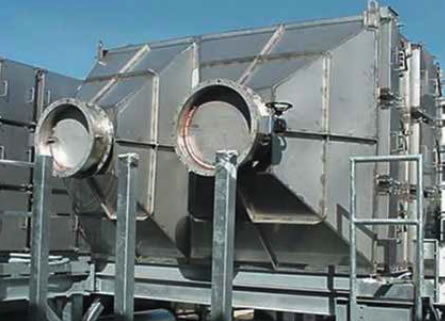
Containment Filtration Systems for the Treatment of Contaminated Air Streams
In 1960, Barnebey Cheney (now Continental Carbon Group, formerly Barnebey Sutcliffe), pioneered the usepioneered the use of special HVAC filter support systems for the nuclear power industry, now known as Containment Systems. They are installed wherever the air to be filtered contains the most hazardous contaminants. Containment Systems include special features for service and maintenance, which provide greater safety for the operator. These features prevent release of the contaminants into the air surrounding the containment system.
Systems manufactured by Continental Carbon Group provide high-efficiency (>99.9% removal) air treatment with provisions for safety during service. These features satisfy current requirements for a wide range of applications.
Filter elements installed in Containment Systems include particulate High-Efficiency Particulate Air (HEPA), Ultra-Low Penetration Air (ULPA) filters, activated carbon High- Efficiency Gas Adsorbers (HEGA) filters, and associated prefilters installed to increase service life of downstream filters.
Containment Systems are supplied with one of two alternative filter clamping methods:
Gasket Seal (CM Series).
A spring-loaded clamping mechanism that compresses a filter gasket providing a positive seal between the filter face and the sealing surface of the housing.
Knife-Edge Seal (KE Series).
A clamping arm is designed to manually engage the filter element into a knife-edge flange. The seal is made when the knife-edge flange penetrates a gel-filled channel provided with the filter element.
A complete Containment System is constructed of modular sections that are factory assembled and tested to suit the demands of a specific application. A typical system consists of an inlet bubble-tight isolation damper (BTD), a prefilter with separate access, housing section to accommodate a standard HEPA or HEGA filter, and an outlet BTD with pressure gauge assemblies and welded transitions. Typically, the housing is combined with a skid, fan, controls, instrumentation, etc., to form a complete “drop-in” system. We also offer installation, start-up, and operator training services.
Quality Design and Protection
Containment Systems Features
- Time and application proven modular design.
- Safe and easy method to maintain filters without contaminating the area outside of the containment system.
- Available in two basic configurations: CM and KE series.
- Change up to three filters (placed in parallel) through a single access port.
- All housings are factory leak-tested to ASME N510 Testing of Nuclear Air Treatment Systems.
- Available for use in vertical or horizontal airflow applications.
- One-piece front panel and back panel construction of rugged 300 series stainless steel.
- Standard housings are designed to withstand 20″ w.g. positive and negative pressures.
Gasket Seal (CM Series) Features
- Accommodates standard gasketed HEPA or HEGA filters.
- A positive spring-loaded filter-locking mechanism that applies constant pressure on each filter.
- The mechanism is operated from outside of the housing using standard tools.
- No special filter clip is required for filter removal.
- Clean-up of seal surfaces not required during filter change-out.
Knife Edge Seal (KE Series) Features
- Less clamping force required to maintain a proper seal.
- Filter access door cannot be reinstalled unless filter latch is properly engaged.
Applications
Federal, State, and Embassies
Government installations require the protection of the public from the discharge of chemical, biological, radioactive, and nuclear agents (CBRN).
Hospitals and Medical Research
Exhaust air from laboratory hoods, hospitals, and/or prison isolation wards may contain radioactive and infectious particulates, and/or gaseous contaminants. Containment Systems safely exhaust filtered air from these facilities to the surrounding environment.
Chemical and Pharmaceutical Industry
Control of air quality and protection of personnel working in the vicinity of lab hoods and research animals requires the use of HEPA filters and activated carbon filters. These filter elements are retained in a Containment System, which permits safe replacement of filter modules.
Military
Government installations evaluating equipment and procedures require the protection of military personnel from the discharge of chemical, biological, and radioactive agents (CBR), or nuclear, biological, and chemical (NBC) warfare agents. Containment Systems are incorporated in the HVAC ventilation systems to prevent release of these agents to the atmosphere.
Schools and Public Buildings
Air quality in schools and other public buildings that are vulnerable to toxic air requires control. Protection is provided by over pressurizing the inhabited spaces with make-up air filtered through a Containment System.
University and Industrial Research Facilities
Many laboratories work with biological and chemical materials requiring special safety procedures such as BSL-3. Containment Systems supplied with appropriate filters are used in conjunction with fume hoods to contribute to the safety of operators, service personnel, and the environment.
Electronics and High Technology Industries
The development of crystals and electronic chip production often require the application of chemicals that could be toxic. Air exhausted from these facilities is filtered in a Containment System prior to venting to the atmosphere.
Genetic Engineering
Cultures are developed under controlled conditions with particulate and vapor phase filtration in exhaust and make-up air systems. These filter elements are contained in Containment Systems, assuring the controlled conditions in the lab are extended to other parts of the facility.
Standard Features
Gasket Seal Design (CM series) and Knife Edge Seal Design (KE Series)
Filter Locking Mechanism – CM Series
- Commercial gasketed filters are clamped securely with 1,400 pounds of force per filter using a spring-loaded top and bottom clamping mechanism.
- 300 series stainless steel construction is used with the exception of brass travel nuts to prevent galling.
- The filter-locking mechanism is actuated from outside the housing using standard tools.
Filter Locking Mechanism - KE Series
- Sealing of the filter elements is provided by a 300 series stainless steel locking mechanism.
- The locking mechanisms press and align the 3/4” wide fluid seal channel of the filter into a knife-edge seal that is welded to the containment housing.
- This mechanism does not allow access door reinstallation if the filters have been incorrectly installed.
Bag Out Port
- The change-out bag is safely secured around a porthole provided with smooth edges to prevent bag rupture.
Removable Filter Access Door
- Filters are easily accessed through a single neoprene gasketed door provided with four non-galling swing-away door clamps.
Separate Prefilter Door
- Separate openings are provided to accommodate 2″, 4″ or 6″ prefilters, which permit changing of prefilters without disturbing the critical HEPA or HEGA seals.
- Downstream contamination of the housing is prevented by locating the sealing surfaces on the upstream side of the filter.
Construction
- Stainless steel construction incorporating single piece front and back panels; limited number of seal welds means smooth internal surfaces to reduce the risk of leakage and accommodate decontamination.
- Welding is performed in accordance withSection IX of the ASME code.
- Housings are rated for 20″ w.g. static pressure (both negative and positive).
- Filter removal rods are provided as standard on two- and three-filter-wide housings. The rods are at the top and bottom of the porthole and are accessed through the filter change-out bag. These rods are used to retrieve filter elements that cannot be easily reached.
Filter Change-out Accessories
- The bag-out bags themselves are of 8-mil. PVC construction and are factory pressure-tested.
- Clear section at bag neck enables technicians to view work.
- An elastic shock cord is hemmed into the mouth of the bag for a positive fit when stretched over the collar of the porthole.
- A special sleeve to remove the stump from the old bag generated during the change-out procedure is formed into each bag.
- A safety strap is provided for operator security. A cinch strap is installed on each bag to ensure that the bag is not drawn into the housing.
Pressure Testing
- Each filter housing is factory pressure tested to 20″ w.g., the highest standard pressure rating in the industry per N510.
- The maximum permissible leak rate per this specification is 0.2% of the housing volume per hour.
- The filter element sealing surface is also factory tested by the pressure decay method.
- ASME-N510 testing is available.
Available Options
Bagless housings do not include the bag-in/bag-out feature, but retain all of the standard features and high quality of the CM Series (Gasket Seal) and the KE Series (Knife Edge Seal) housings that are designed to meet the requirements of ASME N509.
Alternate door arrangements allow for the locating of access doors on the right side, left side, or both sides of the housing. Door location is determined as right or left hand as viewed upstream of the housing and looking downstream. This permits access to filters and the filter removal rod from either side.
A single-access door for the prefilter and primary filter is available with a common door servicing the prefilter and the HEPA (or carbon) filters. While this is a more economical alternative, this arrangement does increase the potential risk of contamination by placing the sealing surface on the downstream side of the high-efficiency filter, thus exposing the entire filter element to the dirty air stream.
A glass-beaded finish is available as an alternative exterior finish.
A removable and fully gasketed weather cap protects the entire top of the housing from accumulation of debris and water in outdoor installations. The material and finish are the same as the housing.
Lifting lugs can be attached to the top of each housing or bank of housings for ease of installation.
Differential pressure gauges can be installed at each stage of filtration to monitor the pressure drop across particulate filters. They are also available with analog transmitters and adjustable pressure switches.
Static pressure taps can be provided across each stage of filtration for customer-supplied gauges or manometers.
Seismic testing, analysis, and documentation per N510 are available.
System Integration Containment Systems can be combined with air handlers fitted with heating/cooling coils.
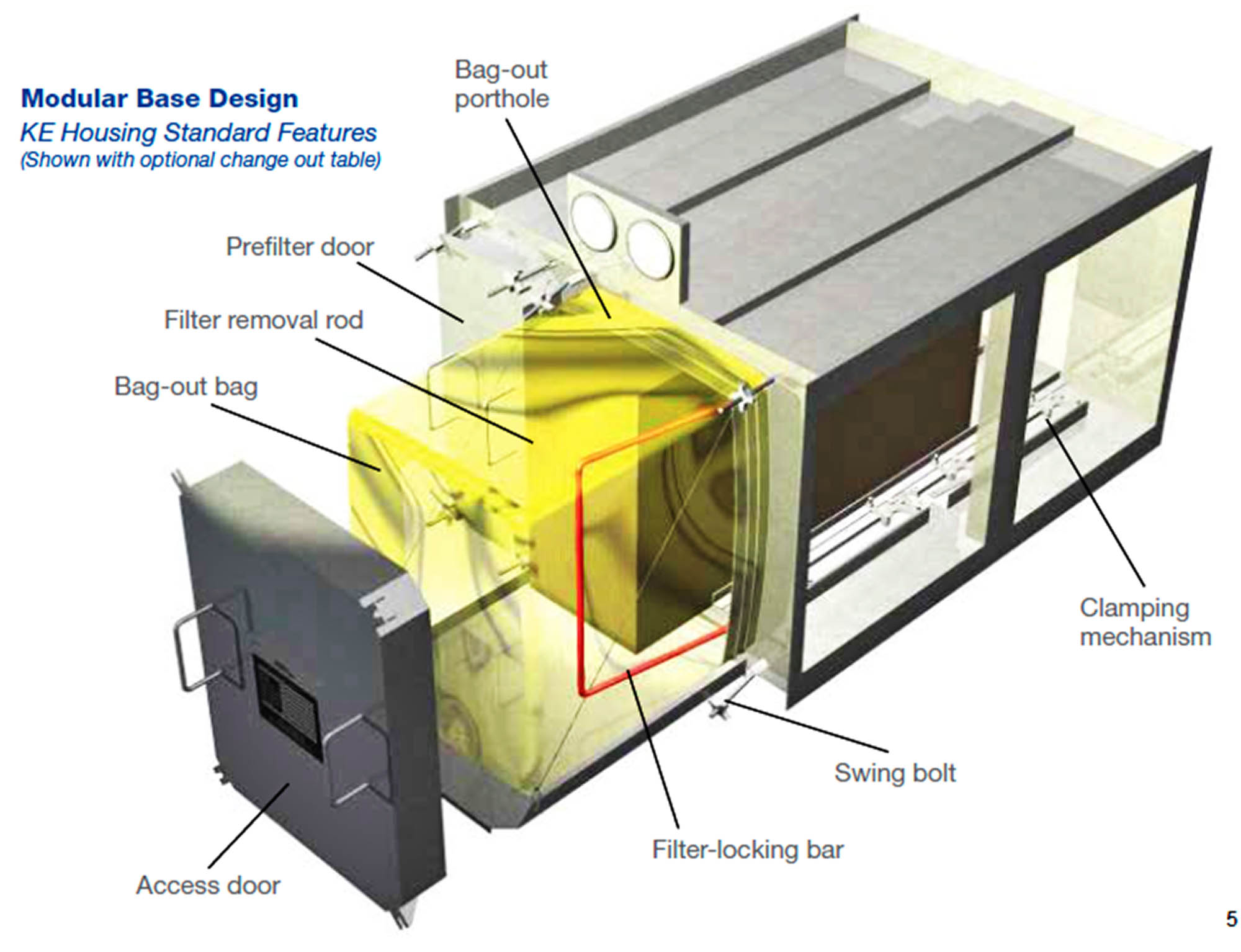

Application:
War Gas destruction off-gas treatment
Location:
Arkansas, USA
Equipment:
Blower, prefilter, HEPA, DMMP carbon tray, test section, transitions
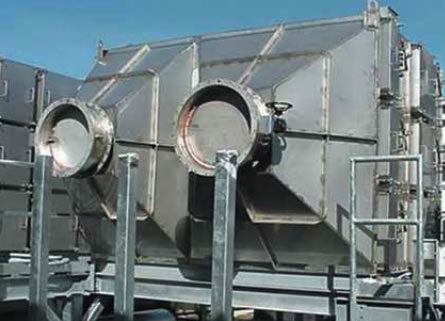
Application:
Biotechnology research laboratory facility
Location:
Virginia, USA
Equipment:
Bubble-tight damper, prefilter, test section, refillable carbon tray, transitions

Application:
Prison collective protection
Location:
Indiana, USA
Equipment:
Blower, prefilter, HEPA, DMMP carbon tray, test section, transitions

Application:
Collective protection system
Location:
Maryland, USA
Equipment:
Blower, prefilter, refillable DMMP carbon tray, test section, transitions
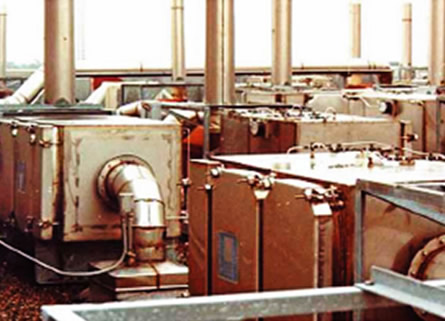
Application:
Hospital lab hood exhausts
Location:
Texas, USA
Equipment:
Prefilter, HEPA filter, and HEGA filter with type 787 carbon for control of radioactive isotopes
Radial Flow (Round) Military NBC Filtration

18,000 cfm
Application
Military war gas air filtration
Location:
Kentucky, USA
Equipment:
Radial flow DMMP air filtration system combined with an air handler and blower sections


Control Panel
Containment Systems Custom Engineered From Modular Design
Containment system configurations can be customized to meet customer requirements.
Below are typical configurations as they apply to several types of filtration applications.
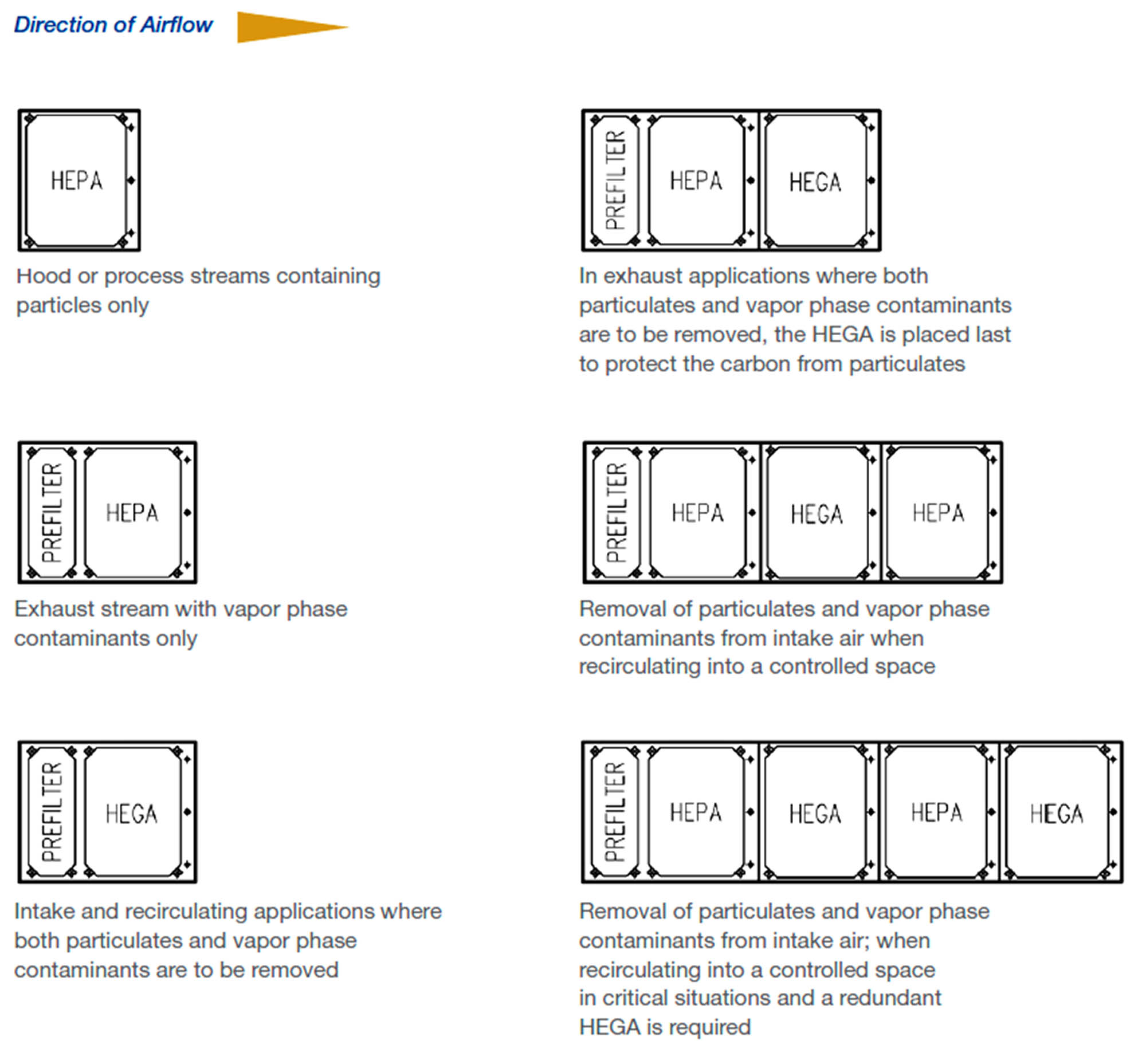

Continental Carbon Group is constantly striving to improve its products and capabilities and to provide the best product to it customers. Continental Carbon Group may from time to time develop product improvements or alterations (including, without limitation, revisions to product specifications), and may implement such Product Improvements without notice to the Buyer.
Making Air Safer and Cleaner
SAFETY MESSAGE
Wet activated carbon removes oxygen from air, causing a severe hazard to workers inside carbon vessels. Confined space/low oxygen procedures should be put in place before any entry is made. Such procedures should comply with all applicable local, state and federal guidelines.
